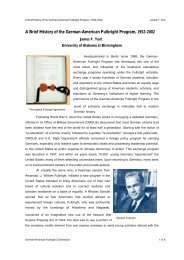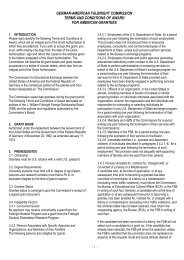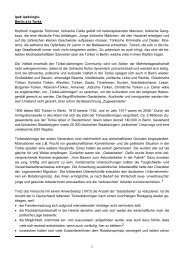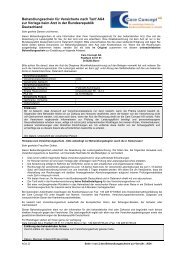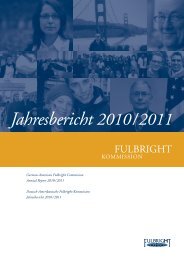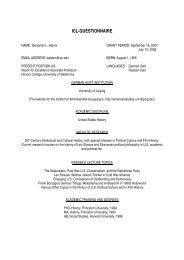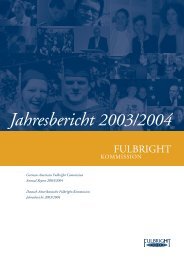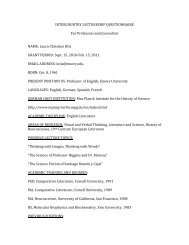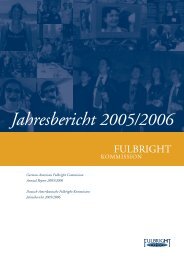Funnel 40/2, Inhalt - Fulbright-Kommission
Funnel 40/2, Inhalt - Fulbright-Kommission
Funnel 40/2, Inhalt - Fulbright-Kommission
Create successful ePaper yourself
Turn your PDF publications into a flip-book with our unique Google optimized e-Paper software.
can get individual advice and support by a specialized immigration<br />
counselor.<br />
Due to my personal interest in immigration I focused my internship<br />
on these activities. Very soon I experienced the enormous importance<br />
the situation of non-documented immigrants had on the general<br />
discourse on immigration.<br />
HERE TO STAY<br />
For the purpose of this short glimpse into the issue I regard as nondocumented<br />
persons those people who came to the U.S. from a different<br />
country and have their primary place of residence in the U.S., but<br />
do not possess a legal residence permit of any kind. I omit the broadly<br />
used term “illegal immigrants” because of its negative connotation.<br />
Determining the number of non-documented immigrants in<br />
the U.S. is a complex undertaking. There is no federal or state census<br />
data available that calculates U.S. residents without legal residency<br />
status. Therefore, estimates often have to replace distinct<br />
data.<br />
A broadly applied method to estimate the total number of nondocumented<br />
persons is to subtract the estimate of legal foreign-born<br />
persons living in the U.S. from the estimate of the total foreign-born<br />
population (Fix & Passel, 2001). By applying this process to data<br />
received from the March 2000 Current Population Survey (CPS) and<br />
the U.S. Census 2000, different studies have proposed numbers ranging<br />
from 7 to 9 million non-documented immigrants. This number<br />
represents roughly 28% of the total amount of the foreign-born population<br />
or around 2% of the overall population of the U.S. (Fix &<br />
Passel, 2001).<br />
The primary country of origin of this population is by far Mexico<br />
(~5 million) followed by El Salvador (~190,000) and Guatemala<br />
(~150,000), according to findings of the former Immigration and<br />
Naturalization Service (INS—now called the U.S. Citizenship and<br />
Immigration Service - USCIS). The states with the highest numbers<br />
of non-documented immigrants are, according to USCIS, California<br />
(2.2 million), Texas (1.04 million), New York (489,000), Illinois<br />
(432,000), and Florida (337,000) (USCIS, 2003).<br />
Research findings indicate that the majority of the non-documented<br />
population do not come to the U.S. on a temporary basis but intend<br />
FROM OUR FULBRIGHTERS 31<br />
to stay permanently (Mehta & Ali, 2003, 17). Therefore it becomes<br />
clear that non-documented persons in the U.S. represent a significant<br />
social group and there are no indicators that suggest the numbers of<br />
non-documented persons in the country or new arrivals will decrease<br />
or that non-documented persons might leave the country after a short<br />
time. The majority of this population will stay here. In fact, I often<br />
meet people who live in Chicago, have a job, and are raising their children<br />
but do not have legal documentation of their residency.<br />
WITHOUT A SAFETY NET<br />
The legal status of non-documented persons keeps them from<br />
accessing support systems such as adequate health care, education, or<br />
childcare and makes it almost impossible to go beyond the very low<br />
levels of professional activity, highly impacting their socioeconomic<br />
situation. While a Chicago-based study, whose results are suported<br />
by an array of other research, found that 91% of the male non-documented<br />
population joined the workforce, the average wage level<br />
(around $7/hour) earned by these workers in predominantly restaurant-related<br />
jobs, hand-picking, and assembly was consistently under<br />
the average wage level earned by the general workforce. Additionally,<br />
only 25% of these employees were covered by any form of health<br />
insurance (Mehta et al., 2002).<br />
These legal barriers towards an improvement of the socioeconomic<br />
situation of non-documented persons are exacerbated by the<br />
comparably low general educational level of immigrants from Mexico.<br />
In the 1990s only 4% of the Mexican-born adult population in<br />
the United States posessed a college degree, one of the main prerequesits<br />
for professional advancement (Szelenyi & Chang, 2002).<br />
And while there is hope for the children of immigrants with legal<br />
documentation to integrate into the U.S. education system, the access<br />
barriers towards these options are much higher for non-documented<br />
immigrants and their families.<br />
From this background arises the argument that private companies<br />
often have an interest in maintaining the status quo, that is, keeping<br />
non-documented workers in the country, but keeping them from<br />
accessing higher-wage jobs in order to be able to draw from a broad<br />
pool of workers, who are ready to work under sub-standard conditions,<br />
enabling the companies to significantly reduce labor costs.<br />
THE FUNNEL • VOLUME <strong>40</strong> • NUMBER 2 • SUMMER 2004



